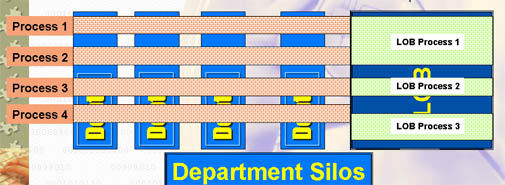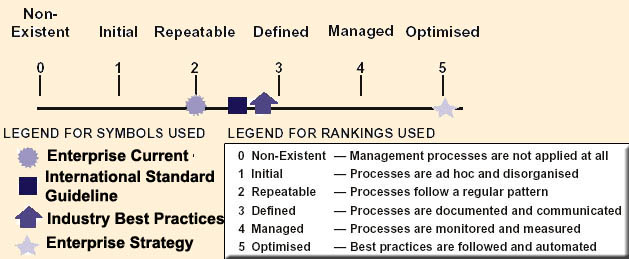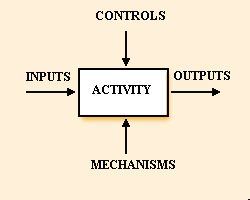
Graphic 1: Organization complexity in IT service provision
| Organizational Structure | Organizational Process Capabilities | Process Modeling |
Most enterprises are not organized along service lines. Traditional organization structures allowed companies to achieve three interrelated goals which have little connection to the service requirements of a customer:
All three, but most certainly the last, of these goals have implications for how a service division should be organized. Traditionally, the division may adopt one or more of four primary organizational models (variants and mixes are common):
Most IT services will involve several divisions and/or functional lines which contribute participants in a "service chain". Companies develop and maintain systems and applications according to IT groups or Line Of Business (LOB) - rather than according to business process or service - resulting in a hodgepodge of packaged, custom and legacy applications.
 Graphic 1: Organization complexity in IT service provision | This diagram illustrates how various processes involve multiple units within the IT division itself. This matrix of organization unit and functions is further complicated when LOBs maintain exclusive or predominant influence over their major applications. With their intrinsically narrow views of the enterprise, these "silos" add to the complexity of managing enterprise applications and create a number of management problems. The lack of visibility across the enterprise hinders the ability to measure service levels and the business impact of problems, obstructs managing availability and performance, and limits the ability to isolate and resolve problems. Since each LOB addresses similar management concerns - often in different ways - management efforts are duplicated, economies of scale are lost, and any prospect of a "big picture" view of the business is wasted by the lack of information sharingR. In large organizations with multiple mission-critical applications, the respective businesses may be reluctant to relinquish any control over the application to a central IT Provider (ie. Application Support) thereby creating complexity and inefficient management. The need for cooperation can lead to friction because units need to acknowledge process hand-offs. |
This need for cooperation is inherent throughout ITIL best practices and requires attention and ongoing scrutiny by the organization wishing to implement, sustain and build upon service improvements:
| "When ITIL is implemented, the support and delivery of IT services is performed via cross-functional processes rather than functional groups. It is up to the organization to determine how those processes will map to the existing organizational structure. In some cases, that structure is changed. In other cases, organizations decide to formulate cross-functional committees to oversee and steer processes. In either case, people are ultimately forced to change how they perform their daily tasks and that is not always met with enthusiasm. These changes can include simple procedural changes, entire process reform, changing the tools that are used, individual job title changes, and changing reporting lines." Problem Management: The Key to Leveraging an ITIL Implementation, Chorus White Paper, March, 2005 |
| Friction occurs at the point where activities, operations, functions, disciplines, departments, or business units interact. Metrics should be placed at these touch points to meaure the amount of friction that occurs.
Mark D Lutcheon, managing IT as a business, Son Wiley & Sons, 2004, ISBN: -0147-14706-6, p. 168. |
The introduction of better workforce practices is a key enabler for implementing new process initiatives and needs to be closely coordinated with better governance models including a review of the organizational structure of the IT service provider.
![]()
Organizational Process Capabilities
People Maturity Modeling suggests that this "friction" and the workforce practices engendered by rigid organizational structures are endemic in less mature organizations. At a minimum the enterprise must ensure a stable work environment. Without this stability introducing new work practices associated with revised or new processes will be problematic...
| At the second level of maturity, organizations must establish a foundation on which they can deploy common processes across the organization. Before being able to successfully implement many advanced practices, management must first establish a stable environment in which to perform professional work. They must ensure that people are not constantly rushing about pellmell, cutting corners, making mistakes from hasty work, and fighting the fires that characterize over-committed organizations. Until basic management control is established over daily work, no organization-wide practices have any chance of being deployed successfully since no one has the time to master them. The primary objective of a level 2 environment is to enable people to repeat practices they have used successfully in the past. To enable this repeatability, managers must get control of commitments and baselines. The effort to establish a repeatable capability is the effort to establish basic management practices locally within each unit or project. Only when this management discipline is established will the organization have a foundation on which it can deploy common processes. |
Defining standard processes is crucial in achieving level 3 process capabilities. In devising its' criteria for assessing the maturity of IT governance process, the Information Systems Audit and Control Association suggest that best practices such as ITIL are targeted to the achievement of a point between maturity levels 2 and 3.

Graphic 2: COBIT Executive Summary |
Most organizations are currently at level 2 - offering Repeatable services. ISO standards reside about half way between levels 2 and 3 while currently described best practices such as ITIL are focused at organizations striving (but not attaining) a defined maturity level. The ultimate goal for all enterprises should be attainment of an " optimizing" maturity level. The reasons for this are aptly described in the following passage from CMMI.
| The organization's set of standard processes, which is the basis for maturity level 3, is established and improved over time. These standard processes are used to establish consistency across the organization. Projects establish their defined processes by tailoring the organization's set of standard processes according to tailoring guidelines. The organization’s management establishes process objectives based on the organization’s set of standard processes and ensures that these objectives are appropriately addressed. A critical distinction between maturity level 2 and maturity level 3 is the scope of standards, process descriptions, and procedures. At maturity level 2, the standards, process descriptions, and procedures may be quite different in each specific instance of the process (for example, on a particular project). At maturity level 3, the standards, process descriptions, and procedures for a project are tailored from the organization’s set of standard processes to suit a particular project or organizational unit. The organization’s set of standard processes includes the processes addressed at maturity level 2 and maturity level 3. As a result, the processes that are performed across the organization are consistent except for the differences allowed by the tailoring guidelines. CMMI |
In the Netherlands, the Kwintes Project applied CMM to the achievement of level 3 service management maturityN. It cited the following key processes for obtaining a Standardized level of IT service management:
Kwintes emphasizes the development of process descriptions and suggests that these process assets should be developed in close parallel with a service catalogue. And, many of the Kwintes recommendations can be found in COBIT (CobIT describes how an organization would work at different maturity levels for 34 essential processes, many of which are further elaborated within ITIL best practice areasN).
To achieve this requires specific capabilitiesN. Most prominent amongst these are Organizational Process Definition, necessary for the organization to retain the accumulated experience of knowledge workers in a structured context. Otherwise, the organization has difficulty institutionalizing and benefiting from shared knowledge - "Organizational process assets enable consistent process performance across the organization and provide a basis for cumulative, long-term benefits".
Definition of Process"A naturally occurring or designed sequence of operations or events, possibly taking up time, space, expertise or other resource, which produces some outcome. A process may be identified by the changes it creates in the properties of one or more objects under its influence." |
Definition of Process"a connected series of actions, activities, changes etc., performed by agents with the intent of satisfying a purpose or achieving a goal. "ITIL, Planning to Implement Service Management, Appendix B 1, Process Theory |
Underscoring the concept of process is a theoretical premise - process theory which holds that if an outcome is to be duplicated, so too must the process which originally created it. There are certain constant necessary conditions for the outcome to be reached. This simple relationship can be extended to include additional relationships. Inputs determine (or, in statistical systems establish tendencies), which when followed by certain activities produce specific Outcomes.
A Process Model can be used to describe activities and their relationships. Process Models are graphical representations of existing or planned processes and can be used to understand what functions are performed and how those functions interact. A process represents an action or task that requires some amount of time to accomplish its objectives. A completed Process Model graphically depicts the specific steps, operations, and information needed to perform a process. Data enters the process, is processed, data comes out, the outcome is measured and reviewed. This very basic expression underlies any process description. The process model may represent as broad or as narrow a viewpoint as is required and may be refined further and into more detail. If several viewpoints are desired, separate models can be developed for each. Some characteristics of a process include:
A process model can be developed to a very fine or very coarse degree of detail. The more precise the model, the more specific it becomes to a particular process as practised in one place. If it is less precise, it can be used with a high degree of generality.
Often information or materials produced in one process are used in others processes. The term "ICOM" is the acronym for the four possible roles relative to a process:
| 
|
| In Planning to Implement Service Management, ITIL presents a somewhat more elaborate description of the ICOM approach. In their description Controls are specifically identified as either Goals and Objectives, values and characteristics associated with a champion or designated process owner and quality parameters including Key Goal and Performance Indicators. Mechanisms are defined as Resources and Roles. | 
|
The following is a fairly exhaustive list of attributes that characterize the robustness of a process. In this sense, robustness refers to the resiliency and durability of a process to withstand abuse, enforce compliance, and be able to measure its effectiveness. The robustness of a process comes in degrees - the absence of a few of these characteristics doesn't mean that a process is weakly designed or poorly executed; however, in general, the more of these attributes that are present, the more robust a process is. Many of these are included in the following list of process elements.
Developing Robust Processes, Lightpointe, Nov 19, 2004 |
Process orientation is often a big change and demands commitment from the management. Without this commitment process orientation initiatives often fail to deliver the expected results. By centering ones attention on processes the focus is also transferred from the finished result to the activities forming them. Since the processes create the result, they are also the first things that have to be controlled and developed. By focusing on core elements, the process view can be applied on an all-embracing level in the organization, seeing the whole organization as one system. Looking at the organization as a system of integrated and interrelated processes is vital for this kind of thinking.R.
I believe that process developing and maintenance is as important a process as any of the ITIL best practices areas. Therefore, I describe the underlying sub-processes which make it up under HCI processes. Access this process for further detail on implementing and sustaining process artifacts.
| Process Implementation Issues |
